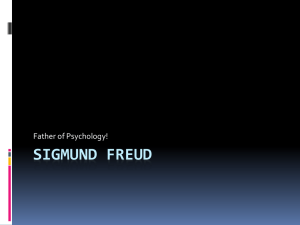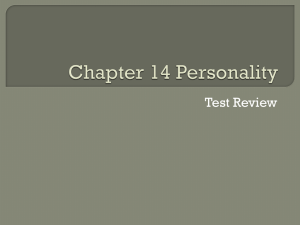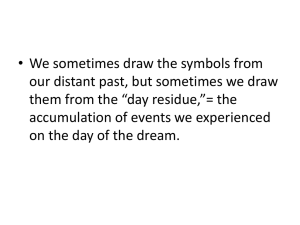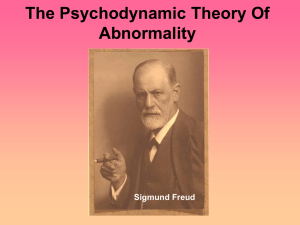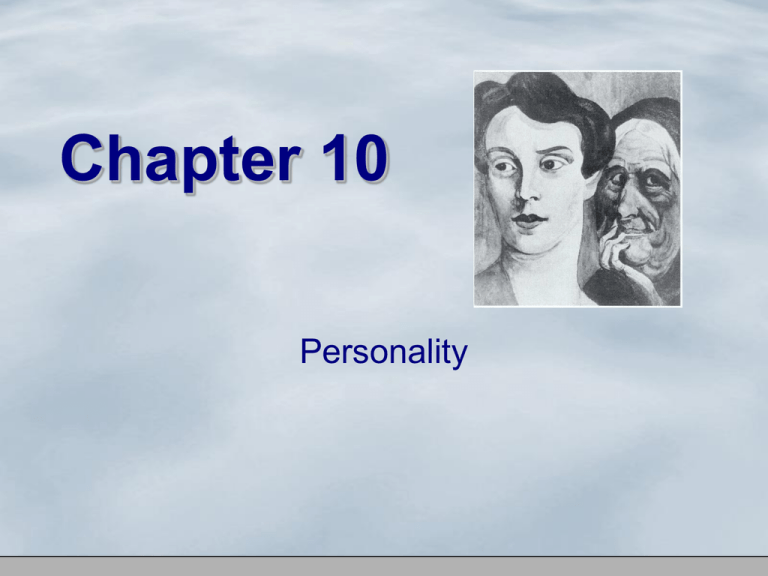
Chapter 10
Personality
Personality
Personality –
Psychological qualities that bring
continuity to an individual’s behavior in
different situations and at different times
What Forces Shape Our
Personalities?
According to the
psychodynamic, humanistic
and cognitive theories,
personality is a continuously
changing process, shaped by
our internal needs and
cognitions and by external
pressures from the social
environment
Psychodynamic Theories
Psychoanalysis–
Freud’s system of treatment for mental
disorders
Psychoanalytic theory –
Freud’s theory of personality
Freud’s Psychoanalytic Theory
Unconscious –
Psychic domain of which the individual is
not aware, but which is the storehouse of
repressed impulses, drives, and conflicts
that are unavailable to consciousness
Freud’s Psychoanalytic Theory
Drives and instincts
Eros
Libido
Thanatos
Freud’s Psychoanalytic Theory
Drives and instincts
Eros
Libido
Thanatos
Drives people toward
acts that are sexual,
life-giving, and
creative
Freud’s Psychoanalytic Theory
Drives and instincts
Eros
Libido
Thanatos
Drives people to
experience sensual
pleasure
Freud’s Psychoanalytic Theory
Drives and instincts
Eros
Libido
Thanatos
Drives people toward
aggressive and
destructive behaviors
Freud’s Model of the Mind
Freud’s Psychoanalytic Theory
Personality structure
Id
Superego
Ego
Freud’s Psychoanalytic Theory
Personality structure
Id
Superego
Ego
Primitive, unconscious
portion of personality,
houses most basic
drives and stores
repressed memories
Freud’s Psychoanalytic Theory
Personality structure
Id
Superego
Ego
Mind’s storehouse of
values, moral attitudes
learned from parents
and society, same as
common notion of
conscience
Freud’s Psychoanalytic Theory
Personality structure
Id
Superego
Ego
Conscious, rational part
of personality, charged
with keeping peace
between superego and
id
Freud’s Psychoanalytic Theory
Psychosexual stages –
Successive, instinctive patterns of associating pleasure
with stimulations of specific bodily areas at different times
of life. Freud believed that one’s personality was set in
childhood. This is the discontinuous view of development
(occurs in stages).
Freud believed that sexual urges were an important
determinant of people’s personality development. Each of
the stages is named for the part of the body from which
people derive sexual pleasure during the stage.
Oral Stage
Anal Stage
Phallic Stage
Latency
Genital Stage
Freud’s Psychoanalytic Theory
Fixation–
Occurs when psychosexual development
is arrested at an immature stage.
Fixation results from being either
undergratified or overgratified.
Psychosexual Stages (Oh A Pig Likes
Grass)
Oral Stage
Birth-1 year: Freud proposed that children enjoy
sucking and biting because it gives them a form of
sexual pleasure.
Desire: Oral Stimulation
Challenge: Overcoming dependency (being dependent on bottle;
weaning).
Oral Fixation: If a child is over fed or underfed, or weaned from the
bottle too early, then that could lead to the following problems later
in life – overeating, too much gum chewing, smoking, nail-biting,
talkativeness, gluttony, gullibility, chewing on objects, etc.
Psychosexual Stages (Oh A Pig Likes
Grass)
Anal Stage
1-3 years: Children are sexually gratified by the act
of elimination (potty training)
Desire: Anal Stimulation by bladder and bowel function.
Challenge: Toilet Training and self-control.
Anal Fixation: If a child has a traumatic toilet training experience,
then that can lead to the anal expulsive personality, which describes
people who are messy or disorganized, or the anal retentive
personality, which describes people who are meticulously neat,
hyperorganized, and a bit compulsive. The adult who is fixated in
this stage can be destructive, cruel, stingy, cold, throw temper
tantrums, and expect to get their way.
Psychosexual Stages (Oh A Pig Likes
Grass)
Phallic Stage
3-5 years: Sexual gratification moves to the genitalia.
Desire: Stimulation of genitals (not considered abnormal!)
Challenge: Resolving Oedipus/Electra Complex, involving erotic
attraction to parent of opposite sex and hostility to parent of same
sex.
Phallic Fixation: If a child does not adequately resolve the issue of
being able to identify who they are and know that they cannot have
their opposite-sex parent as a mate, then they can become jealous
adults, have egocentric sex, have many sexual partners in life as if
they were trying to conquer something, or have problems in later life
with their own parents. They may also be too sexually assured or
aggressive, or consumed with their own sexual inadequacies.
Freud’s Psychoanalytic Theory
Oedipus complex –
According to Freud, a largely unconscious
process whereby boys displace an erotic
attraction toward their mother to females of their
own age and, at the same time, identify with
their fathers. For girls, this is known as the
Electra Complex.
Freud’s Psychoanalytic Theory
Identification –
The unconscious mental process by which
an individual tries to become like another
person, especially the
same-sex parent. This defense mechanism
is meant to protect the conscious mind from
thoughts that are too painful (can you
imagine if you knew that you were in love
with your opposite sex parent???!!)
Freud’s Psychoanalytic Theory
Penis envy–
According to Freud, the female desire to have a
penis– a condition that usually results in their
attraction
to males.
Castration anxiety – According to Freud, boys
specifically fear that their fathers will castrate
them to eliminate them as rivals for their
mothers, so this keeps them behaving,
identifying with their father, and shifts their
attention to girls their own age.
Psychosexual Stages (Oh A Pig Likes
Grass)
Latency
6 years - puberty: All sexual feelings are pushed out
of conscious awareness (repression). Focus shifts to
school and how children act with their peers.
Desire: Repression of sexual and aggressive desires.
Challenge: Consciously: learning modesty and shame.
Unconsciously: dealing with a repressed Oedipal/Electra conflict.
Latent Fixation: If a child is shamed or embarrassed, then as an
adult the child may develop excessive modesty. Freud also
considered a fixation in this stage to lead to the preference for
company of the same sex or homosexuality (by today’s psychological
standards, this is not a disorder – Freud believed it was.)
Psychosexual Stages (Oh A Pig Likes
Grass)
Genital Stage
Puberty -Adulthood: Sexual pleasure is attained
through sexual relationships with others.
Desire: Mature sexual relationships.
Challenge: Displacing energy into healthy activities and establishing
new relationships with parents.
Genital Fixation: None – this is due to the fact that if you enter this
stage without having fixations in the other stages, then you will have
healthy relationships.
Freud’s Psychoanalytic Theory
Ego defense mechanisms –
Largely unconscious mental strategies employed to reduce the
experience of conflict or anxiety. It is the job of the ego to
protect the conscious mind.
• Repression
• Denial
• Projection
• Reaction Formation
• Regression
• Rationalization
• Displacement
• Sublimation
Freud’s Psychoanalytic Theory
Projective tests –
Personality assessment instruments
based on Freud’s concept of projection
•Rorschach Inkblot Test
•Thematic Apperception Test
Freud’s Psychoanalytic Theory
Psychic determinism –
Freud’s assumption that all mental and
behavioral reactions are caused by
unconscious traumas desires or conflicts
ANNA FREUD
• DAUGHTER OF
SIGMUND FREUD
• THE HAMPSTEAD
CHILD THERAPY
CLINIC
• ANALYSIS OF
CHILDREN
• DEFENSE
MECHANISMS
CARL JUNG’S ANALYTICAL PSYCHOLOGY
• BACKGROUND &
EARLY YEARS
• HE BEGAN TO
WRITE TO FREUD
• HE EMPHASIZED
THE
UNCONSCIOUS
DETERMINANTS
OF PERSONALITY
EXTENDING THE UNCONSCIOUS
LAYERS
• THE PERSONAL UNCONSCIOUS HOUSES
MATERIAL THAT IS NOT WITHIN ONE’S
CONSCIOUS AWARENESS BECAUSE IT
HAS BEEN REPRESSED. PORTION OF THE
UNCONSCIOUS CORRESPONDING
ROUGHLY TO FREUD’S ID.
• THE COLLECTIVE UNCONSCIOUS IS A
STOREHOUSE OF LATENT MEMORIES
INHERITED FROM OUR ANCESTRAL PAST.
JUNG’S ARCHETYPES
• ARCHETYPES ARE
EMOTIONALLY
CHARGED IMAGES
THAT HAVE
UNIVERSAL
MEANING
• THEY APPEAR IN
ART, LITERATURE,
AND RELIGION
Carl Jung: Extending the Unconscious
Archetypes
Animus
Anima
Shadow
Carl Jung: Extending the Unconscious
Archetypes
Animus
The male archetype
Anima
The female archetype
Shadow
Carl Jung: Extending the Unconscious
Archetypes
Animus
Anima
Shadow
Archetype representing
the destructive and
aggressive tendencies
we don’t want to
recognize in ourselves
INTROVERT VS. EXTROVERT
• INTROVERT=
INNER-DIRECTED,
PREOCCUPIED
WITH THE WORLD
OF THEIR OWN
THOUGHTS
• EXTROVERT=
INTERESTED IN
OTHER PEOPLE &
THINGS
Carl Jung: Extending the Unconscious
Jung’s principle of opposites portrays each
personality as a balance between
opposing pairs of unconscious
tendencies, such as introversion and
extroversion
Karen Horney: A Feminist Voice in
Psychodynamic Psychology
Basic anxiety –
An emotion that gives a sense of
uncertainty and loneliness on a hostile
world and can lead to maladjustment
Neurotic needs –
Signs of neurosis in Horney’s theory,
these ten needs are normal desires
carried to a neurotic extreme
See the chart on page 421 in your book.
10 Neurotic Needs – Normal desires taken to the
extreme.
1. Need for affection and
approval.
2. Need for a partner and
dread of being left alone.
3. Need to restrict one’s life
and remain inconspicuous.
4. Need for power or control
over others.
5. Need to exploit others (take
advantage of others for
your own profit).
6. Need for recognition or
prestige.
7.Need for personal
admiration.
8.Need for personal
achievement.
9.Need for self-sufficiency and
independence.
10.Need for perfection.
Karen Horney
• 3 patterns of attitudes and behavior that
people use to deal with basic anxiety,
either in a healthy way or in a neurotic
way.
• Moving toward others, against others,
away from others.
Moving Toward Others
• It is neurotic when a person needs constant
reminders of love and approval.
• These people need someone to help, to take
care of, or someone for whom to “sacrifice”
themselves.
• They often feel victimized and become
dependent.
Moving Against Others
• Power and respect is earned by competing or
attacking successfully.
• They risk ending up “alone at the top.”
Moving Away From Others
• It is neurotic when a person avoids others to
protect themselves from imagined hurt or
rejection (“I won’t make friends because they
might hurt me.”)
• In doing so, they close themselves off to
intimacy and support and healthy relationships.
INDIVIDUAL PSYCHOLOGY
• ADLER FELT
FREUD HAD GONE
OVERBOARD IN
CENTERING HIS
THEORIES ON
SEXUAL
CONFLICTS
• MORE IMPORTANT
IS A STRIVING
FOR SUPERIORITY
COMPENSATION
• COMPENSATION
INVOLVES
EFFORTS TO
OVERCOME
DEFICIENCIES
• INFERIORITY
COMPLEX
• OVERCOMPENSATION
ORDINAL POSITION
• BIRTH ORDER IS A
MAJOR FACTOR IN
THE DEVELOPMENT OF
PERSONALITY
• DIFFERENT
ENVIRONMENTS
FOR DIFFERENT
SIBLINGS
Humanistic Theories
Humanistic Theories include
Gordon Allport’s trait theory
Abraham Maslow’s self-actualizing personality
Carl Roger’s fully functioning person
Gordon Allport and the Beginnings of
Humanistic
Traits –
Stable personality characteristics that are
presumed to exist within the individual
and guide his or her thoughts and actions
under various conditions
• Central traits form the basis of personality
• Secondary traits include preferences and
attitudes
• Cardinal traits define peoples lives
Abraham Maslow and the Healthy
Personality
Self-actualizing personalities –
Healthy individuals who have met their
basic needs and are free to be creative
and fulfill their potentials
CARL ROGERS
• CLIENT-CENTERED
THERAPY
• CCT PROVIDES A
SUPPORTIVE
ENVIRONMENT
• IN CCT, THE CLIENT
DETERMINES THE
PACE & DIRECTION
OF THERAPY
CARL ROGERS
• ANXIETY IS CAUSED BY
INCONSISTENCY
(INCONGRUENCY)
BETWEEN A PERSON’S
SELF-CONCEPT AND
REALITY.
• HOW YOU PERCEIVE
YOURSELF
• FULLY FUNCTIONING
PERSON
Carl Rogers’s Fully Functioning
Person
Phenomenal field –
Our psychological reality, composed of
one’s perceptions and feelings
Unconditional positive regard –
Love or caring without conditions
attached
Evaluating Humanistic Theories
Positive psychology –
Movement within psychology focusing on
the desirable aspects of human
functioning, as opposed to an emphasis
on psychopathology
Cognitive Theories:
Social Learning and Personality
Observational learning –
Process of learning new responses by
watching the behavior of others
Reciprocal determinism –
Process in which the person, situation
and environment mutually influence each
other
Reciprocal Determinism
Cognition
Environment
Behavior
Locus of Control
Locus of control –
An individual’s sense of where his or her
life influences originate
Current Trends in Personality Theory
Family systems theory
Cultural differences
Gender influences
What Persistent Patterns are
Found in Personality?
Another approach describes
personality in terms of stable
patterns known as
temperaments, traits, and
types
What Patterns are Found in
Personality?
Humors –
Four bodily fluids that, according to
ancient theory, control personality by
their relative abundance
Blood
Phlegm
Black Bile
Yellow Bile
Personality and Temperament
Temperament –
Basic, pervasive personality dispositions that
are apparent in early childhood and establish
the tempo and mood of an individual’s
behaviors
Type –
Especially important dimensions or clusters of
traits that are not only central to a person’s
personality but are found with essentially the
same pattern in many people
Patterns in Personality
The “Big Five” traits
1. Openness to experience (closed
mindedness)
2. Conscientiousness (carelessness)
3. Extraversion (introversion)
4. Agreeableness (negativity)
5. Neuroticism (emotional control)
Cattell identifies 16 personality factors
Assessing Traits
NEO-PI (Big Five Inventory)
Minnesota Multiphasic Personality
Inventory (MMPI-2)
Reliability and validity are important
attributes of good psychological tests
Traits and the Person-Situation
Debate
Person-situation controversy –
Theoretical dispute concerning the
relative contribution of personality factors
and situational factors in controlling
behavior
What “Theories” Do
People Use to
Understand Each Other?
People everywhere develop
implicit assumptions (“folk
theories”) about personality,
but these assumptions vary
in important ways across
cultures
Implicit Personality Theories
Implicit personality theories –
Assumptions about personality that are
held by people to simplify the task of
understanding others
Fundamental attribution error –
Assumption that another person’s
behavior (especially undesirable
behavior) is the result of a flaw in the
personality, rather than in the situation
Personality Across Cultures
Assumptions people make vary widely across
cultures–depending especially on whether the
culture emphasizes individualism or
collectivism
Other cultural differences involve
•
•
•
•
•
•
Status of different age groups and sexes
Romantic love
Stoicism
Locus of control
Thinking vs. feeling
Attribution
End of Chapter 10




